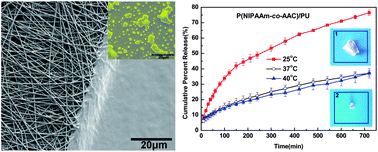Stimuli-responsive electrospun nanofibers from poly(N-isopropylacrylamide)-co-poly(acrylic acid) copolymer and polyurethane
Abstract
A thermo- and pH-sensitive copolymer of poly(N-isopropylacrylamide)-co-poly(acrylic acid) (P(NIPAAm-co-AAc)) with an adjusted lower critical solution temperature (LCST)(at 37 °C) in an aqueous medium and pH of 7.4 was synthesized by a radical copolymerization, and was characterized by Fourier-transform infrared (FTIR) spectroscopy and 1H nuclear magnetic resonance (1H-NMR) spectroscopy. Then, nanofibers composed of P(NIPAAm-co-AAc) and polyurethane (PU) were fabricated by the single-spinneret electrospinning technique and used as drug carriers by co-spinning with the water insoluble drug nifedipine (NIF). The thermo-responsive behavior of the nanofibers was detected by contact angle (CA) measurements. The release behavior of the NIF from nanofibers was observed by scanning electron microscopy (SEM) and demonstrated by UV-vis spectroscopy. It was found that the wettability of the P(NIPAAm-co-AAc) nanofibers could be switched, due to the incorporation of PU. The release amount of NIF from the nanofibers could be controlled effectively by adjusting the temperature or pH value of the aqueous medium and incorporating the hydrophobic PU.


 Please wait while we load your content...
Please wait while we load your content...